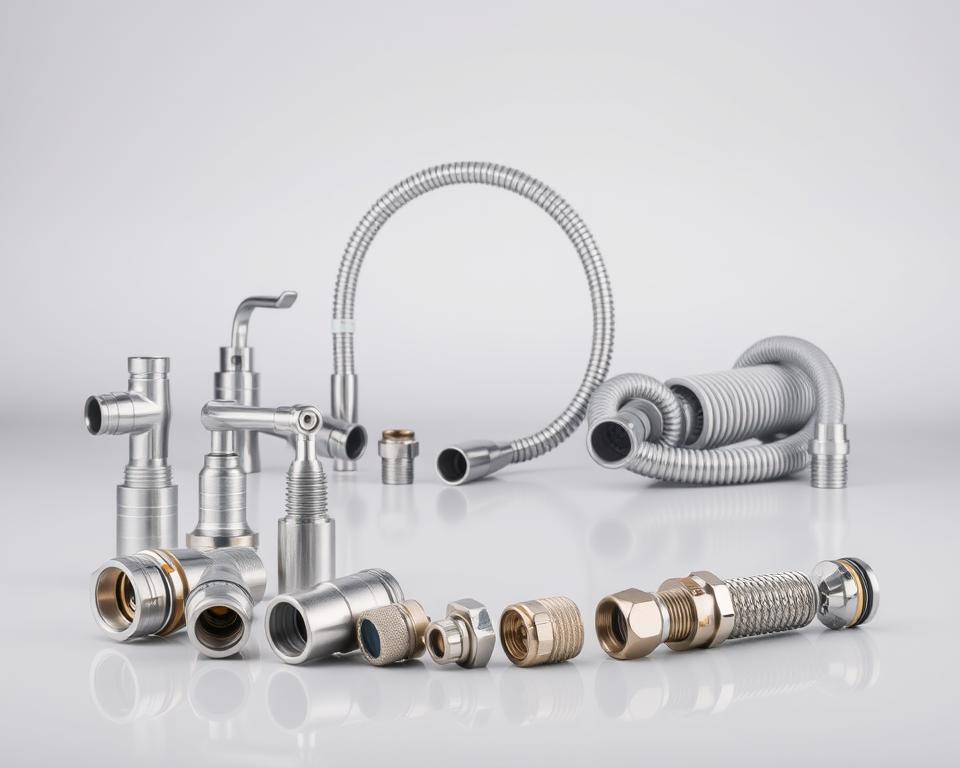Definitive Guide to Kitchen Sink Hose Attachments
Were you aware attaching a kitchen sink hose attachment can reduce your water bills? While the specific reductions vary, the addition carries significance. A premier kitchen sink hose attachment boosts both performance and sustainability, elevating any kitchen. This definitive manual delves into their significance, benefits, and how they transform everyday kitchen tasks, such as veggie cleansing and utensil scrubbing.
Versions from 2016 and 2017 differ in stamina and practicality. Regardless of their release period, installation correctness is key; this usually entails detaching strainers or screens, necessary in all cases. Routine servicing is also critical to keep sink faucet connector at peak performance.
At Installation Parts Supply, we offer a diverse selection designed for different sinks, emphasizing durability and usefulness. We will further explore the varieties, perks, and maintenance for kitchen sink hose attachments.
Important Discoveries
- Attaching a kitchen sink hose attachment can lower water bills.
- Proper installation guarantees optimal operation; removing screen filters is a essential step.
- Upkeep your hose attachment by cleaning it regularly.
- The type of material affects durability; PVC is prevalent but can kink.
- Leak inspection post-installation is essential for effective performance.
- Utilizing top-grade clamps boosts longevity and pressure tolerance.
- Explore options at Installation Parts Supply for various kitchen needs.
Overview to kitchen sink hose Connections
A kitchen sink hose attachment links with your faucet for easy water flow management. They come in variants like brass-finished and quick connect. This design improves mobility, enabling users to reach tough spots effortlessly. An cost-effective attachment can improve kitchen functionality and simplify tasks.
What is a kitchen sink hose Device?
This device features a flexible hose that extends water flow precisely to the required area. Manufactured from materials like brass and polymer, providing varied durability options. Featuring both pull-out and pull-down styles, they are perfect for multiple applications. These tasks include washing dishes and produce rinsing.
Benefits of Utilizing a kitchen sink hose Attachment
Kitchen sink hose attachments offer numerous advantages. They enable versatile water flow regulation, optimizing spray patterns and flow path. This versatility aids in cleaning constricted spots or large objects. They are simple to install, requiring no professional help. With different price options, it’s simple to locate a cost-effective choice, while seamlessly upgrading your kitchen.
Types of kitchen sink hose Devices
Discovering the appropriate kitchen sink hose attachment is crucial for satisfying your requirements. Each option has unique roles, complete with distinctive advantages. Familiarizing yourself with both bendable and rigid selections, together with garden hose connectors, boosts your kitchen’s functionality.

Bendable kitchen sink hose Devices
Flexible kitchen sink hose attachments deliver unmatched adaptability. Suited for navigating difficult locations around the sink, they make rinsing dishes or washing fruits and vegetables a breeze. Their capability to maneuver into narrow spaces is highly valued. The demand of these attachments continues to grow due to their utility and user-friendliness.
Rigid kitchen sink hose Attachments
Rigid kitchen sink hose attachments are known for their rigidity, providing consistent water flow. They’re indispensable for pot filling or rinsing bulky objects with effortlessness. Constructed from robust materials like stainless steel, they resist wear and tear efficiently. They are favored by users for their anti-leak properties, demonstrating their reliability for daily use.
Adapters for Garden Hoses
Adapters for garden hoses link kitchen faucets with outdoor hoses seamlessly. They serve as an asset in outdoor tasks, from watering the garden to washing outdoor furniture. These adapters cut down on manual effort, preventing the need to move water-filled buckets. Since most faucets are compatible with garden hoses, they provide wide adaptability and user-friendliness.
Deciding on the Optimal kitchen sink hose Attachment
Choosing the right kitchen sink hose attachment necessitates reviewing various factors. Such considerations improve both efficiency and ease in your kitchen space. It’s critical to seek out products that offer longevity and are made from high-grade materials. Ease of installation and the fitting of the attachment with your sink play a pivotal role in making the best choice.
Strength and Material Standards
In your quest for a durable kitchen sink hose attachment, focus on the construction materials. Selections including stainless steel, granite, and premium plastics deliver durability. They are known for their resistance to wear and tear. Selecting a robust model, you ensure years of consistent operation, keeping it in optimal condition despite frequent handling.
Ease of Installation
A kitchen sink hose attachment offering effortless setup simplifies the complete installation. Many models are designed for straightforward installation, suited for users without advanced technical skills. Choose an attachment that comes with simple instructions and all the needed parts. This ensures a rapid and hassle-free installation process.
Compatibility with Your Sink
Ensuring your kitchen sink hose attachment aligns with your sink is crucial. Most sinks feature pre-drilled holes for this purpose. You must opt for an attachment that complements your sink’s style. Proper compatibility eradicates issues such as drips, making sure your attachment operates perfectly.
Easy Installation of kitchen sink hose Add-ons
Mounting a kitchen sink hose attachment may appear difficult. Nonetheless, a straightforward set of instructions streamlines the process. This straightforward method allows anyone to enhance their kitchen’s efficiency. It describes a detailed process for attaching a kitchen sink hose, featuring the required equipment.
Sequential Setup Instructions
Begin by assembling all necessary components and instruments. Employ an aerator removal tool to detach the faucet’s aerator. Determine if your faucet has male or female threads for proper connection. Wrap Teflon tape around the faucet spout to ensure a tight, watertight seal.
Then, attach the suitable faucet adapter. Confirm a firm attachment to prevent leaks. Place a rubber gasket for a firm bond; ensuring leak prevention when correctly installed. Apply vinyl grip tape to the wrench to protect surfaces from scratches during use. Be particularly careful not to damage the threads, which can harm the faucet.
When a vacuum breaker is absent, adding a hose-type vacuum breaker is wise for maintaining system integrity. Always depressurize the hose before removal to stop water from splashing.
Required Tools
| Instrument | Purpose |
|---|---|
| Tool for Removing Aerators | For removing the aerator from the faucet |
| Sealant Tape | Wrap the faucet spout for a watertight seal |
| Adjustable Wrench | Fasten the faucet adapter safely |
| Elastic Seal | Guarantee a firm connection to avoid leakage |
| Vinyl Grip Tape | Shield surfaces from scratches during use |
Maintaining Your kitchen sink hose Device
To make sure your kitchen sink hose attachment functions properly and remains durable, routine upkeep is essential. By adopting proper cleaning methods and recognizing the need for replacement, you can avert major issues down the line.
Guidelines for Cleaning and Care
Preserving the hygiene of your kitchen sink hose attachment is essential for its performance. A solution of white vinegar (5-10% acetic acid) is excellent for dissolving mineral deposits that result in obstructions. Consider these some helpful cleaning tips:
- Immerse the sink sprayer cover in vinegar for a minimum of 1.5 hours to ensure complete cleaning.
- In legacy models, disassemble the sprayer so as to immerse its elements like the disk with perforations, protective sleeve, and washers.
- In newer models, simply rotate the spray head in the reverse direction to gain access to its inside elements.
- An alternative method for contemporary sprayers is to dip them in a vinegar-soaked bag, making sure the sprayer is entirely submerged, for an identical period of 1.5 hours.
Since hard water minerals frequently cause sink sprayers obstructions, consistent maintenance is vital for uninterrupted function.
When to Change Your Hose Attachment
Knowing when to replace your kitchen sink hose is essential for avoiding plumbing issues. Look for these indicators:
- Leaks often mean the hose material is breaking down, which means it’s time for a new one.
- Visible cracks in the hose signal a decline in integrity.
- Lower water pressure may signal blockages or damages, suggesting a replacement is needed.
Regular proactive care of your kitchen sink hose attachment substantially boost its longevity, ensuring optimal kitchen performance.
The Bottom Line
Including a kitchen sink hose attachment can greatly improve your kitchen’s efficiency. Our comprehensive guide discussed the categories, benefits, and maintenance tips of hose attachments. If you aim to upgrade your kitchen chores or upgrade your space, a hose attachment offers versatility and performance.
These accessories offer better heat management and liquid distribution. They facilitate removing food debris easy, ensuring a pristine space. Their benefits in daily kitchen operations are unquestionable, enhancing your cleaning process significantly.
Upgrading your kitchen need not be difficult or costly. With options for every budget and design preference, a kitchen sink hose attachment could radically change your culinary space. Selecting premium models, like those from Installation Parts Supply, you ensure long-lasting use and satisfaction.
Common Inquiries
Understanding a kitchen sink hose attachment?
This device connects with your faucet, turning it into a sprayer. This modification enhances the adaptability of water flow. It simplifies activities such as washing and horticulture.
How do I install a kitchen sink hose attachment?
When setting up, begin by removing your faucet’s aerator. Afterwards, connect the right faucet adapter. Make sure all connections are firm and leak-proof. Usually, you will require an adjustable wrench and Teflon tape.
What should I consider when choosing the best kitchen sink hose attachment?
When selecting, focus on durability, material quality, simple setup, and fit with your sink and faucet. Stainless steel or superior plastics ensure greater longevity.
Are kitchen sink hose attachments are simple to care for?
Yes, maintenance is straightforward. Employ vinegar for cleaning to eliminate mineral buildup. Frequently check for leaks and clogs. Change the device if it shows cracks, leakage, or reduced water flow.
Is it possible to use a kitchen sink hose attachment for outdoor tasks?
Yes, when used with garden hose adapters, it’s perfect for outdoor activities like watering the garden.
Do cost-effective kitchen sink hose attachments?
Certainly, the market features a variety of budget-friendly options. Installation Parts Supply provides a range that marries affordability with quality.
Comparing flexible and rigid hose attachments: what sets them apart?
Flexible hose attachments bend to reach challenging angles, boosting adaptability for multiple applications. Rigid hose attachments keep their form, guaranteeing stable water flow direction. They tend to be more durable.

